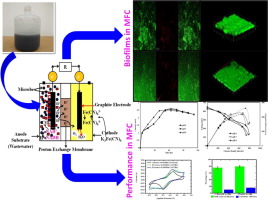Our official English website, www.x-mol.net, welcomes your
feedback! (Note: you will need to create a separate account there.)
Comparative study on Cronobacter sakazakii and Pseudomonas otitidis isolated from septic tank wastewater in microbial fuel cell for bioelectricity generation
Fuel ( IF 6.7 ) Pub Date : 2019-07-01 , DOI: 10.1016/j.fuel.2019.03.060 Boobalan Thulasinathan , Samsudeen Nainamohamed , James Obeth Ebenezer Samuel , Saravanan Soorangkattan , JothiBasu Muthuramalingam , Mohanrasu Kulanthaisamy , Ravindran Balasubramani , Dinh Duc Nguyen , Soon Woong Chang , Nanthi Bolan , Yiu Fai Tsang , Leonel Ernesto Amabilis-Sosa , Arun Alagarsamy
Fuel ( IF 6.7 ) Pub Date : 2019-07-01 , DOI: 10.1016/j.fuel.2019.03.060 Boobalan Thulasinathan , Samsudeen Nainamohamed , James Obeth Ebenezer Samuel , Saravanan Soorangkattan , JothiBasu Muthuramalingam , Mohanrasu Kulanthaisamy , Ravindran Balasubramani , Dinh Duc Nguyen , Soon Woong Chang , Nanthi Bolan , Yiu Fai Tsang , Leonel Ernesto Amabilis-Sosa , Arun Alagarsamy

|
Abstract The potential of microbial isolates from septic tank wastewater to generate bioelectricity in microbial fuel cell was investigated. The isolates were identified as Cronobacter sakazakii AATB3 and Pseudomonas otitidis AATB4. The sterilized septic tank wastewater alone was used as an organic matter to study the exact role of the isolates in bioelectricity production and biodegradation of septic tank wastewater. P. otitidis AATB4 achieved the highest bioenergy generation (i.e., power density of 280 mW/m2 and current density of 800 mA/m2), highest COD removal (i.e., 79.1%), and maximum coulombic efficiency of 15.5% at pH 7. The biofilm of P. otitidis AATB4 at the anodic surface contained 49 µg/cm2 of protein and 57 µg/cm2 of carbohydrate. Scanning electron microscope and confocal laser scanning microscope revealed 46 µm biofilm thickness by P. otitidis AATB4 in the electrode for stable power generation. It is concluded that P. otitidis AATB4 can be used as a novel bioelectrogen in microbial fuel cell for sustainable energy production using septic tank wastewater.
中文翻译:

化粪池废水中分离出坂崎克罗诺杆菌和耳炎假单胞菌的微生物燃料电池生物发电对比研究
摘要 研究了从化粪池废水中分离出的微生物在微生物燃料电池中产生生物电的潜力。分离株被鉴定为坂崎克罗诺杆菌 AATB3 和耳炎假单胞菌 AATB4。单独使用经过消毒的化粪池废水作为有机物来研究分离物在化粪池废水的生物发电和生物降解中的确切作用。P. otitidis AATB4 实现了最高的生物能源发电(即,功率密度为 280 mW/m2,电流密度为 800 mA/m2),最高的 COD 去除率(即,79.1%)和在 pH 7 时的最大库仑效率为 15.5%。 P. otitidis AATB4 在阳极表面的生物膜含有 49 µg/cm2 的蛋白质和 57 µg/cm2 的碳水化合物。扫描电子显微镜和共聚焦激光扫描显微镜显示 P. 生物膜厚度为 46 µm。otitidis AATB4 在电极中稳定发电。得出的结论是,P. otitidis AATB4 可用作微生物燃料电池中的新型生物电源,用于利用化粪池废水进行可持续能源生产。
更新日期:2019-07-01
中文翻译:

化粪池废水中分离出坂崎克罗诺杆菌和耳炎假单胞菌的微生物燃料电池生物发电对比研究
摘要 研究了从化粪池废水中分离出的微生物在微生物燃料电池中产生生物电的潜力。分离株被鉴定为坂崎克罗诺杆菌 AATB3 和耳炎假单胞菌 AATB4。单独使用经过消毒的化粪池废水作为有机物来研究分离物在化粪池废水的生物发电和生物降解中的确切作用。P. otitidis AATB4 实现了最高的生物能源发电(即,功率密度为 280 mW/m2,电流密度为 800 mA/m2),最高的 COD 去除率(即,79.1%)和在 pH 7 时的最大库仑效率为 15.5%。 P. otitidis AATB4 在阳极表面的生物膜含有 49 µg/cm2 的蛋白质和 57 µg/cm2 的碳水化合物。扫描电子显微镜和共聚焦激光扫描显微镜显示 P. 生物膜厚度为 46 µm。otitidis AATB4 在电极中稳定发电。得出的结论是,P. otitidis AATB4 可用作微生物燃料电池中的新型生物电源,用于利用化粪池废水进行可持续能源生产。































 京公网安备 11010802027423号
京公网安备 11010802027423号